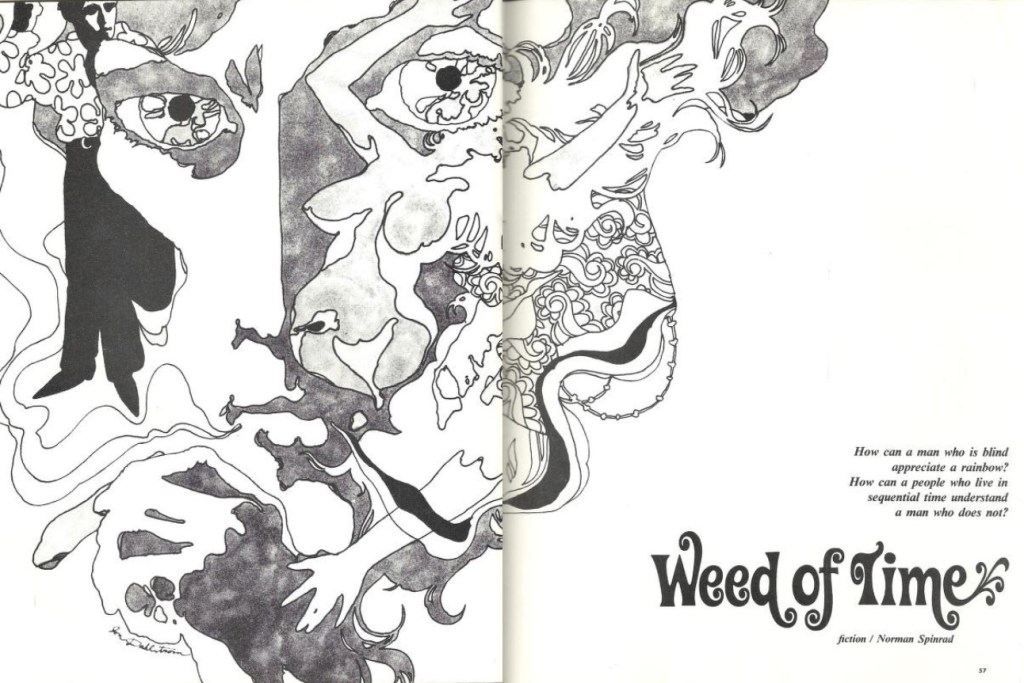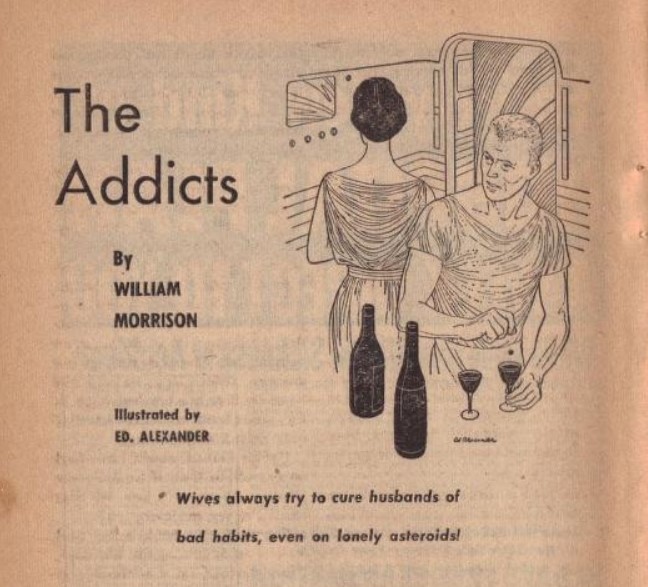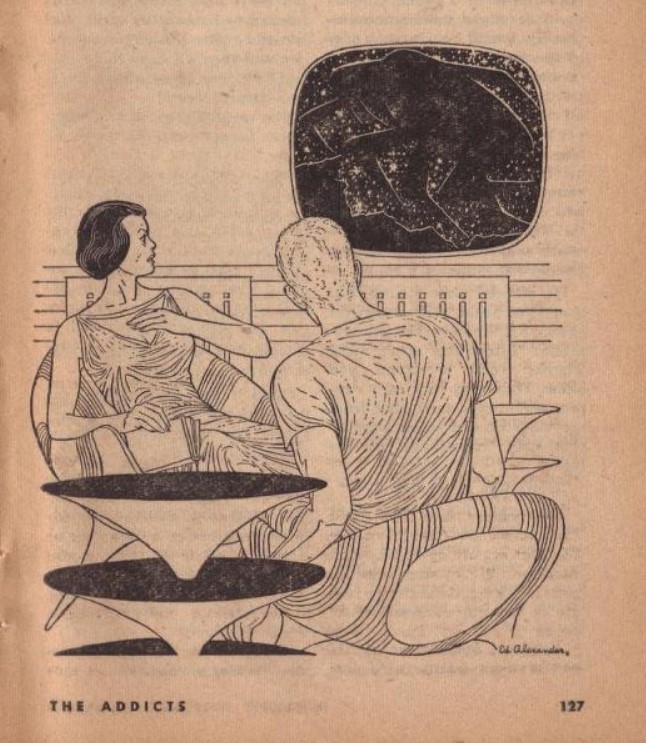Today I’ve decided to do something a bit different. Over the past year or so I’ve been compiling short stories on various themes and I put three of the themes to vote on the hellscape that is Twitter (I’m @SFRuminations). And science fictional drugs won out!
If this topic is interesting, let me know. My notebook contains a substantial list of stories I haven’t yet read on the topic. If you know of other short stories from the decades of my interest (1945-1985), leave a note in the comments.

Charles Moll’s cover for the 1st edition of Norman Spinrad’s No Direction Home (1975)
4/5 (Good)
Norman Spinrad’s “The Weed of Time” first appeared in Alchemy and Academe, ed. Anne McCaffrey (1970). You can read it online here. I read it in his collection No Direction Home (1975) above with its striking Charles Moll cover.
As I’ve mentioned in the past, I’m relentlessly drawn to New Wave movement because there was a serious and conscience attempt to tell stories in artful ways replete with “literary” prose, radical structure/politics, non-standard SF characters/perspectives. Sometimes it’s beautiful. Sometimes it doesn’t work. But it’s all fascinating. This one works.
Now let’s enter the landscape of a transformed mind… At birth, the nameless narrator emerges “an infant-child-youth-man-ancient, in a government cell in a mental hospital dying in clean white sheets” (1979). He sees immediately the “gestalt painting of [his] lifespan, a pattern of immutable events painted on the stationary and external canvas of time….” (78). He experiences all the actions of his life simultaneously (79). No knowledge can effect any “action performed in any particular time-locus” (79). He babbles incessantly about the effects of consuming tempis ceti, an alien plant accidentally released on earth before the astronauts had even returned from their journeys. Of course, all prophesized occurs… and all businesses want to exploit prophesy even if the oracle already knows the irrelevancy of it all.
“The Weed of Time” is redolent with all the signifiers of the New Wave movement. It’s experimental in structure. It’s non-sequential. It explores the traumatized inner space of a user of an alien drug. And as an added bonus, the interior art by Jon Dahlstrom it received in its later Vertex magazine publication, resembles a legion of Counterculture album covers. Spinrad succeeds in creating a highly readable experiment on non-sequential time. Unlike some New Wave stories, the radical structure is part and parcel with the story’s objective–to convey the purgatorial effects of an alien drug.
Recommended for fans of the New Wave movement. I should go ahead and read the rest of his collection No Direction Home (1975). Also check out my reviews of The Iron Dream (1972) and The Last Hurrah of the Golden Horde (1970).

Jon Dahlstrom’s interior art for Norman Spinrad’s “Weed of Time” in Vertex: The Magazine of Science Fiction, ed. Donald J. Pfeil (August 1973)

Don Sibley’s cover for Galaxy Science Fiction, ed. H. L. Gold (January 1952)
3/5 (Average)
William Morrison’s “The Addicts” first appeared in Galaxy Science Fiction, ed. H. L. Gold (January 1952). You can read it online here.
This is the first story I’ve read by William Morrison (aka Joseph Samachson) (1906-1980). According to SF Encyclopedia, his SF writing career can be divided into two halves. He wrote “sporadically” for pulp magazines between 1941-1944. He returned to the SF magazines in the early 1950s–he also wrote for DC Comics–and responded to “the demands for more mature SF.” His work is described as “deceptively simple stories about the human/alien condition” with a “dark humor suggesting throughout his writing career he was using SF to show human limitations.” I recently acquired “Country Doctor” (1953) in the first volume of the Star Science Fiction Stories series, described as his “best story.” “The Addicts” is included in the SF Encyclopedia entry as a story of note.
“The Addicts” imagines a far future lighthouse with all the amenities of a futuristic suburban 50s home crewed by a couple amongst the asteroid belt. A series of disasters have occurred off screen–strange alien entities perambulate around its exterior waiting for the humans to emerge, the beam it emits has failed preventing rescue, and Louise’s husband Jim is addicted to marak. And marak addicts believe that the unaddicted are “miserable, depraved creatures, practically subhuman” (123). Louise, without radio or television due to interference, attempts to argue with him about the need to come up with any plan. But Jim is happy in his comfortable home with absolutely nothing to do as, in his view, the drug leaves him “calm and in full command of his faculties” with no need for stimulus (124). Jim decides the only way to prevent his wife’s nagging is to make sure she too joins the ranks of the marak fiends. But she has something up her own sleeve.
This is a humorous story told with a beguiling lightness that only vaguely masks the domestic nightmare that transpires—wife, utterly severed from the external world, attempts to maintain sanity in the bleak expanse of space with husband transformed by drugs! Morrison’s sympathies lie with the trapped housewife who tries her best to rectify the scenario.

Ed Emshwiller’s interior art for William Morrison’s “The Addicts” in Galaxy Science Fiction, ed. H. L. Gold (January 1952)

Ed Emshwiller’s interior art for William Morrison’s “The Addicts” in Galaxy Science Fiction, ed. H. L. Gold (January 1952)
For book reviews consult the INDEX
For cover art posts consult the INDEX
For TV and film reviews consult the INDEX
I’d always remembered that story very fondly, but I thought it was by Silverberg. I’m delighted to re-encounter it. Thank you.
Is there a story in No Direction Home where a soldier is sent into a ufo which has killed everyone who went in before by any chance?
No problem! It feels like something Silverberg could have written as well 🙂
I’m not sure about the rest of the stories in No Direction Home. Other than “The Weed of Time,” I haven’t read them — yet.
Here’s the listing. Maybe the title will ring a bell: https://www.isfdb.org/cgi-bin/pl.cgi?24341
“The Addicts” might not be something I’d enjoy, but “Weed of Time” sounds super. I’m glad to know it exists. Thanks, Dr. B. I hope you’re recovering from the semester well.
I still have to finish my grading this weekend so it isn’t over yet!
But yes, “The Weed of Time” is a New Wave gem. Can’t say the topic of drugs and SF interests me that much… but silly twitter spoke and for once I carried out a plan. haha.
If you want more drug stories, look at DRUG THEMES IN SCIENCE FICTION by no less than Robert Silverberg, published by no less than the National Institute on Drug Abuse in 1974. It lists a number of his own works among others. It seems about equally divided between short fiction and novels. A conspicuous omission is PKD’s “Faith of Our Fathers” from DANGEROUS VISIONS, which you’ve probably read, but if not you should. The bibliography can be found at
https://books.google.com/books?id=OBiLtxHESRwC&printsec=frontcover&source=gbs_ge_summary_r&cad=0#v=onepage&q&f=false
As John Boston as Yeah, Dick’s ‘Faith of Our Fathers’ is the one to read.
The story annoys some readers because the ending doesn’t add up to make full, logical sense. But then why the hell should it? In fact, that may be the point of it. Interestingly, in a writing career that seemed fairly full of characters hallucinating and on drugs, Dick himself thought of ‘Faith of Our Fathers’ as his ‘drug story’ and said that after he wrote that was when everything fell apart for him.
The title story of the anthology , ‘No Direction Home,’ by Spinrad is also a cute little drug-themed story, or at least has a cute ending. (It’s a story someone was bound to write and Spinrad happened to be the one who wrote it).
I must confess, I plan on avoiding all PKD for this series — if it even becomes a series. I have a notoriously frustrating difficulty writing about his work–despite my general interest in it–for a variety of reasons that I won’t get into here. I seem to remember reading that one as a teen but I can’t remember specifics.
I plan on using Francois Rouiller’s monograph Stups et fiction: Drogue et toxicomanie dans la science-fiction (2003) to compile some more interesting fictions!
I saw mention of the Silverberg text in an online sample of Francois Rouiller’s Stups et fiction: Drogue et toxicomanie dans la science-fiction (2003) that I just purchased (it hasn’t arrived yet) to compile additional stories. My French has gotten a bit rusty post-PhD and thought it would be a good idea to read some SF scholarship to polish it back up!
I might have read the PKD short in my late teens but I can’t quite remember specifics.
Having just read “The Weed of Time” through your link, it’s the third piece I’ve read by Norman Spinrad, but not his best, which was probably the one in “Dangerous Visions”. I thought it was fairly good, with readable prose and internal dialogue, even if it was a bit confusing at times. As you say, it’s “new wave” and experimental, and not standard SF. It’s all those things, but I’m not sure if the premise of a drug that’s alien, was necessary to the importance of the theme, that was about the destructiveness of drugs.
Richard: Yeah, many New Wave authors seem to fall on the “drugs are destructive” side of things — Brian W. Aldiss comes to mind. According to Paul Kincaid’s biography of him I finished a month or so ago, it doesn’t seem like we have any evidence that he actually took drugs despite the centrality in some of his works — like Barefoot in the Head.
Well, I think the best SF usually takes a negative view of anything that’s non-beneficial, that includes about technology. I haven’t read anything by Aldiss about drugs, but I don’t think he did take any. Once again though, in writing about them, I should think he was more concerned with their more dangerous aspects.
Just re-read The Weed of Time in my copy of No Direction Home for the first time in so long I don’t remember reading it before! (Quite probably back in 1977 when my copy was published)
For comparison, I also read two of his other ‘drug’ stories that I have, No Direction Home itself, and Subjectivity in the anthology Strange Ecstasies (Michel Parry, ed). I’ve read this one at least 2 or 3 times, dating back to his Last Hurrah of the Golden Horde collection back in 1970, but I never bought a copy for myself – I borrowed it several times from the library.
The Weed of Time was definitely the most New Wave of them and probably the one with most to think about.
No Direction Home was fairly straight forward, about a society which relies so much on mood-changing drugs, etc. that people can’t even imagine plain reality! The third one, Subjectivity, was probably the most lightweight, about a spaceship crew who have to take hallucinogens to cope with the pressures of space travel, and the measures they have to take as a result!
Ah, do you think the “Subjectivity” story fit my subversive/critical accounts of space travel series?
Glad you enjoyed “The Weed of Time” reread.
Pretty sure Subjectivity would count as ‘subversive’!
Good good. I’ll put it on the list. Yeah, this is the only criteria I’m following for the series: “SF short stories that are critical in some capacity of space agencies, astronauts, and the culture which produced them.”
I recently featured two Ellison short stories: https://sciencefictionruminations.com/2022/12/09/short-story-reviews-harlan-ellisons-psycho-at-mid-point-1956-and-the-discarded-variant-title-the-abnormals-1959/
I think it fits, and it’s only around a dozen pages long so not too much of a waste of time if you end up feeling it doesn’t!
I’ll put it on the list. Thank you!